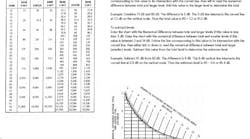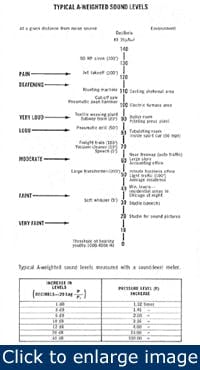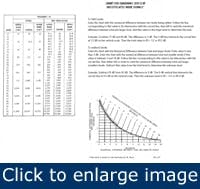3 ways to meet industrial noise standards
Just about everything one does involves motion, and motion produces sound. As industrial machinery evolves to improve efficiency, greater motion can produce increased noise. Although manufacturers are designing equipment to be quieter, the fact remains: Where there’s industrial equipment, there’s noise.
Noise can impair hearing, increase blood pressure and heart rate, cause gastrointestinal responses and produce negative psychological effects. It’s a common misconception that noise must be loud to be damaging. The sound of a dripping faucet, the hum of a transmission, or a high-pitched gear mesh frequency are examples of noises that aren’t loud, but are grating to the ear and potentially can cause harm to workers who are exposed to these sounds for long periods of time.
The basics of sound
Figure 1. Typical A-weighted sound levels correlate with various activities and noise sources.
To understand what causes noise and how to minimize it, one must first understand the basics of sound. The audible frequency range falls between 20 Hz and 20,000 Hz. However, the human ear has trouble hearing frequencies much below 200 Hz or above 10,000 Hz. Although humans’ hearing frequency range might be limited, the ear can distinguish a range of pressure fluctuation from very low levels to very high levels, which gives the ear an increased sensitivity of about 10^-9 power or one billionth. Because of the large values that characterize this high sensitivity, a decibel (dB) is used to define sound levels. Figure 1 provides a table of common decibel levels and relates them to sounds with which most people are familiar.
Although the concept is helpful for understanding relative decibel levels, it can’t provide an accurate measure of the intensity of sound in an environment, which is critical to meeting regulations and industry standards. A pressure-sensitive instrument called a sound level meter captures an accurate value of sound intensity. But like the human ear, the device can be fooled and indicate the wrong level and frequency. A sound level meter outfitted with the wrong microphone or used in the presence of wind, electromagnetic fields or other interference might indicate false readings. Therefore, to capture an accurate reading, it’s important that the person operating the meter know how to use the instrument properly and be aware of the electrical and acoustical characteristics of the area being measured.
Because the sound level meter discerns frequency better than the human ear, various weighting networks or filters have been established so that the meter reading will come closer to indicating what the human ear hears using the standardized “A,” “B” and “C” weighting scales. The “A” scale is a filtering system that roughly matches the human ear’s response at sound levels below 55 dB. The “B” scale roughly matches the ear at levels between 55 dB and 85 dB, and the “C” scale is for sounds louder than 85 dB. The “A” scale (sound pressure level measured in dB “A”) has received prominence because of its use by the Occupational Safety and Health Administration (OSHA), for measuring levels to 115 dB.
Regulating noise
[pullquote]The next step is making sure your facility complies with industry and government noise standards. On May 17, 1969, the occupational noise-exposure regulation portion of the Walsh-Healey Act went into effect. This applied only to companies engaged in government contacts. Then, the Occupational Safety and Health Act of 1970 (84-Stat. 1950) took the same noise regulations and extended them to cover more than 55 million workers in any business engaged in interstate commerce. At the same time, industry began developing its own standards for safety and satisfactory equipment sound levels to guide operators in discovering potential problems with gearing equipment.
Industry standards tend to focus on the sound level that is normal or satisfactory for the type of equipment or application, while government regulations delineate the sound level that is acceptable or safe for workers in the area of the operating equipment.
Both areas of concern are difficult to evaluate because of the inconsistencies in measuring the sound power of sources, the variable characteristics of environments and variability in human sensitivity to noise. Therefore, general or acceptable guidelines have been established as acceptance criteria.
Equipment sound level specifications are stated in terms of eight principal octave band levels. American Gear Manufacturers Association (AGMA) Standard 6025-D98 “Sound for Enclosed Helical, Herringbone and Spiral Bevel Gear Drives” is the current industry standard. This document describes the instrumentation, measuring methods and test procedures necessary to determine a gear unit’s sound pressure level. While AGMA offers guidance about normal or satisfactory sound levels for geared equipment, OSHA and the Walsh-Healey Public Contracts Act provide rules and regulations for occupational noise exposure. These regulations also offer guidance for determining the safe, acceptable sound level for people who work with the equipment.
OSHA requires you to know the geographic position of the people relative to the sound source and the duration of their exposures. For example, an operator can stand five feet away from a gear unit generating 98 dB “A” for a maximum of two hours per shift.
Figure 2. This chart is used for combining uncorrelated noise signals.
Another important consideration for determining compliance is additive noises. In most plants, workers are subjected to noise from multiple sources. This means the individual sound levels need to be combined into a single value. The chart in Figure 2 can help with the mathematics of sound addition. Assume that a plant has four gear motors that generate equal amounts of sound energy yielding a total of 94 dB “A” and the plan is to quiet things down a bit.
To cut the noise to 91 dB “A,” two of the gear motors would have to be turned off. To get below the OSHA limit of 90 dB “A,” a third gear motor would have to shut down, leaving one gear motor that produces about 88 dB “A.” In the real world, it might not make sense to shut down production equipment just to meet the regulations. That’s why it’s important to understand how sound levels can be reduced without affecting production operations.
Killing some sound
After investigating sound levels and reading the industry standards and government regulations, a common question is how to reduce the generated sound level. The three general approaches to doing this include:
- Enclose or isolate the source to shield the operators from the noise
- Absorb the sound that might normally be reflected
- Eliminate (or reduce) the sound using improved equipment quality or design
Generally, absorption and isolation are the most economical ways to reduce sound levels because some noise is the result of machine design and can’t be reduced through redesign or improved quality. However, from an operation standpoint, the most desirable way to reduce noise levels is through design and quality improvements.
Reducing noise and vibration via smoother operation tends to reduce dynamic loads and improve the life of gears, bearings and couplings. Although retrofitting for noise reduction is an option, the best time to solve a noise problem is during the design phase. Tweaking a design before the hardware is manufactured adds little to the cost but might make a significant difference in noise reduction. However, to complicate matters, it’s critical to achieve a balance between noise and performance.
Inform the manufacturer of potential sound level concerns during the design phase. Variables such as tooth profile, pitch, surface finishes, bearings and housings can be modified to meet the dual goal of increased performance and reduced sound levels.
Noise and noise abatement in the workplace is an ongoing industrial challenge, but understanding the basics of sound, current regulations and standards, and ways to minimize sound levels makes the challenge a little easier.
Jules DeBaecke is vice president of engineering at Philadelphia Gear in King of Prussia, Pa. Contact him at [email protected] and (800) 766-5120.


